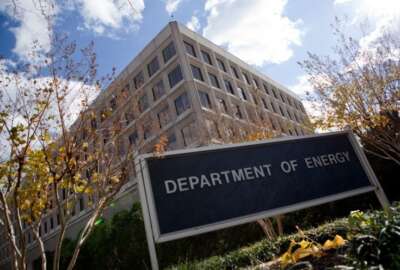

The Energy Department has launched a $30 million grant program to support increasing domestic supplies of rare-earth element.
Best listening experience is on Chrome, Firefox or Safari. Subscribe to Federal Drive’s daily audio interviews on Apple Podcasts or PodcastOne.
If you like electric cars, then you’ve got to have ample supplies of critical elements needed to make them, like lithium and cobalt. Trouble is, the U.S. is highly dependent on foreign sources for most of the 35 rare-earth elements needed for batteries, wind turbines and other items. Now the Energy Department has launched a $30 million grant program to support increasing domestic supplies of rare-earth elements. For details, we’ll have two guests. For an overview of the program, Federal Drive with Tom Temin heard from the acting director of the Materials Sciences and Engineering Division in Energy’s basic research unit, Dr. Andy Schwartz. (Click here for part two)
Interview transcript:
Tom Temin: Andy, good to have you on.
Dr. Andy Schwartz: Thanks, Tom.
Tom Temin: Let’s talk about this program, the basic context for it. What is the public policy here that this grant program, and it’s a fairly large one, is aimed at remediating or supporting?
Dr. Andy Schwartz: Yeah, thanks Tom, That’s a great question. And let me just take a step back and talk about in general what we try to support within the Office of Basic Energy Sciences, where I sit. Our mission is really to support fundamental research to understand, predict and eventually control matter and energy at the most basic level at the electronic, atomic and molecular level. And the reason to do that is to provide a foundation a scientific foundation for new energy technologies, and in general to support the DOE mission, emissions and energy environment and national security. So in short, BES research establishes foundational knowledge on which future technological advances can be made. So in this particular case, related to critical materials, the program is supporting critical materials research in really two primary areas. One is expanding the understanding and the role of both rare earth platinum group and other critical elements in the determination of the properties of materials and molecules at length scales ranging from the electronic to atomic to microstructural, and eventually to sort of macroscopic scales. And the second is to advance geoscience and separation science to enhance the extraction and chemical processing of critical elements.
Tom Temin: So a lot of these rare earth elements we source overseas, because there are abundant in those places. It sounds like the implication is that they are here, but they’re in low concentrations, so that we need better technologies for getting sufficient quantities out of a whole bunch of dirt.
Dr. Andy Schwartz: Yes, that’s right, Tom. I mean, one of the things about rare earth elements, it turns out, they’re not all that rare in the Earth’s crust, but they tend to be diluted, they’re not highly concentrated. And so where they are mined, and there are some sources in the US, and there have been, but you are right that most of the current sources for rare earth elements are internationally and where they are mined, they are often mined in a mixture with lots of other elements. And so that extraction process, how do you separate efficiently and also sustainably in an environmentally sustainable way? How do you separate the elements you want the rare earth elements from the rest of the mixture in a way that allows you to use them for the technologies one?
Tom Temin: And these particular elements, and I’m focusing on cobalt for a minute, because I wrote about the cobalt market when I used to write about metals markets 40 years ago. And that was an issue of supply and so forth. Is the issue for the United States now that we’ve always used these materials in a variety of applications, but now the need is much greater in terms of quantity, because of electric cars, and windmills and all that other good stuff?
Dr. Andy Schwartz: Yeah. So cobalt is an example of one. And there are many that the US published a list of 35 critical materials a couple years ago, it’s being updated now. And they’re going to Department of Interior that leads that effort of maintaining the list. But yes, cobalt is one. You know, one of the challenges with this space of critical elements is that what is critical at a given time changes, right, and based on the sources based on the supply chain, and based on the technology needs, as you just pointed to so yes, as cobalt, which is an element that is used in batteries, it becomes more in demand that can put pressure on the supply chain. So two of the things we talked about at Department of Energy is diversification of supply, looking for more sources, looking for ways to get these elements out of different sources, including recycled sources, for example. So the same challenges of extraction, when you talk about natural resources actually comes with recycled sources that we have this diverse feedstock that we put into a recycling plant. How do we extract out what we want from that? And also looking for substitutes? When you get back to the basic science that we support here in this part of the department? One of the things we look at is let’s understand what are the properties of cobalt that make it so valuable for these technologies? And then try to figure out if we can understand that, are there alternatives that we can use because if there are alternatives that can mitigate some of the supply chain risks.
Tom Temin: And getting to the grants program itself. You mentioned that some groups will be looking at the molecular structures and how to engineer these materials. Others will be looking to devise ways to extract it more efficiently, what types of organizations do you expect to apply for these grants? I mean, mining companies, or is it more of an academic type of pursuit at this point?
Dr. Andy Schwartz: Yeah, great question, Tom. Mostly it’s academic and national labs. So DOE, we operate 17 national labs. It’s a huge national lab…
Tom Temin: We know them and love them well.
Dr. Andy Schwartz: Great, wonderful. And universities, of course, academic research, we support academic research at 300 plus universities currently in lots of different topics. Most of the applications we receive in response to this, because of the fundamental long term science nature of it are likely to be from universities and national labs, though, industry and nonprofit research organizations are also eligible to apply. And actually they can partner, there can be multi institutional applications that might be led by a national lab, but they might bring in an industry partner who has a particular expertise that is relevant to the research they’re proposing. So we’re hoping to really get some applications from across a diverse school of institutions.
Tom Temin: And are these grants stage type of grants where say, the first group will come up with promising ideas, then you narrow it down for more funding and second stage, or how does this particular grant program work?
Dr. Andy Schwartz: Yeah, we typically don’t do that kind of staged approach that you describe, most of the grants that we make our three tear awards, three years of funding, so the ones that are successful that come out of this competition will receive three years of funding, pending budget appropriations and all that. But most threats are also eligible at the end of a three year funding period to submit a proposal for renewed and continued support. And it’s competed typically openly. You know, again, that’s pending on three years from now, what are the priorities, what’s the budget allow, and all of those caveats. But because this is fundamental research, it doesn’t often get completed a lot. Some will happen in three years, but we believe that providing longer term sustained support, so most likely what would happen is Yeah, we make three year awards to a group of awardees, they perform research, we’re evaluating them manually for progress reports. And then at the end of that three years, again, if there’s programmatic desire to do so, and budgetary support, they would be given an opportunity to re compete and say, hey this is what we’ve done, and now here’s what we’d like to do going forward from here.
Tom Temin: And the findings here do have strategic and commercial importance for the country. At some point, do you envision a pathway for the learnings and the results of the grants research to become commercialized so that we can start mining lithium and the 35 other elements that are buried out there in the deserts?
Dr. Andy Schwartz: Yes, absolutely. I mean, the long term goal, of course, is to have this science of impact, not all of it, it’s basic research. And the nature of basic research is that some of it will end up moving forward and having impact and others won’t. But one of the key elements of that is to make sure that the people who are doing the basic research are well connected with the people are interested in applied research technology development and commercialization. And that that’s really a two way conversation, right. So that the people doing the science really understand what are the real challenges technologically and they can to steer their science in a direction to try to attract those challenges. And vice versa, that people doing technology development and commercialization, see the innovation coming out of the science and say, hey I saw that, there’s a great scientific discovery, we can make use of that in our technology space. So one way we do that is close coordination. So the Office of Science where I sit, the Office of Energy Efficiency and Renewable Energy has strong programs in this area, the Office of Fossil Energy, of course, is heavily involved. The Office of Nuclear Energy. And those are more recent ARPA-E, Advanced Research Projects Agency for Energy, also has investments in this area. And we coordinate closely internally in the department to ensure that we all understand what’s being done in different spaces, and that that information and knowledge can get passed back and forth.
Tom Temin: So bottom line, then we are aiming just as we aim for independence in fossil fuels earlier, we are aiming for some degree of rare earth elements independence now.
Dr. Andy Schwartz: Absolutely. I mean, the goal, the long term goal is to establish sustainable, reliable domestic supply chains for the railroads and for others, right. The railroads are a subset of all the critical materials, they get a lot of attention, and they’re certainly important. But lithium is not a rare earth and cobalt’s not a rare earths. And some of the ones we’ve mentioned already are also important. So for all of these, yes, the goal is to establish reliable, sustainable and if possible domestic supply chains in the long term.
Tom Temin: Andy Schwartz is acting director of the materials sciences and engineering division for basic research at the Energy Department. Thanks so much for joining me.
Dr. Andy Schwartz: Great. Thanks Tom, I’m really happy to have been here.
Copyright © 2024 Federal News Network. All rights reserved. This website is not intended for users located within the European Economic Area.
Tom Temin is host of the Federal Drive and has been providing insight on federal technology and management issues for more than 30 years.
Follow @tteminWFED


